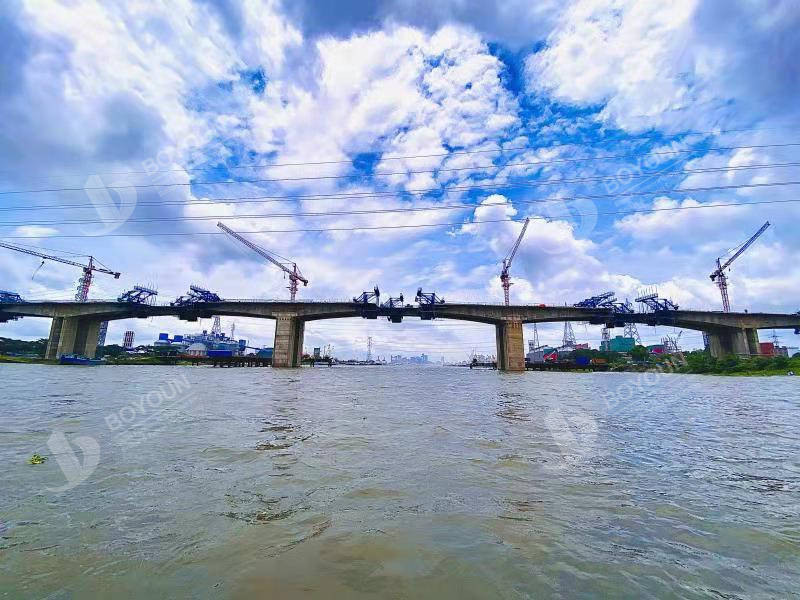With the development of society, the number of bridge engineering projects has increased, and the construction speed has accelerated. Quality issues in bridge construction have attracted growing attention. As the social and economic level improves, strengthening quality management in construction has gradually become a long-term strategic task. This article mainly introduces four common bridge construction quality issues.

In bridge engineering construction, the hand-dug bored pile construction method is generally adopted. Each section of the wall protection is formed by manual formwork erection. It is crucial to ensure the accuracy of the pile diameter, verticality, and central position during construction. Therefore, relevant personnel must strictly inspect and review the pile foundation quality according to formal procedures, ensuring thorough verification before drawing conclusions. After completing the hand-dug operation, inspectors should use a hole detector to specifically measure the accuracy of the pile diameter and verticality. Additionally, the strength of the wall protection concrete should be one grade higher than that of the cast-in-place pile concrete, with a thickness of more than 15 cm. The concrete must be vibrated densely and adhere tightly to the hole wall to achieve the real effect of wall protection.
The steel reinforcement cage should be fabricated according to the design formwork, hoisted into the hole as a whole, and positioned effectively to ensure the thickness of the protective layer around the pile diameter meets actual requirements. Any abnormal conditions must be recorded immediately. For pile foundations with abundant groundwater, the accumulated water in the hole should be drained as much as possible to ensure the construction quality of bridge concrete. If water sealing is difficult, underwater concrete construction should be carried out. When calculating the quantity of the first batch of concrete, ensure it can wrap the lower opening of the 导管 (conduit) with sufficient volume and continuous pouring. Pay attention to maintaining the burial depth of the conduit between 2m and 4m and ensure the conduit is firmly connected with good sealing performance.
2. Column Pier Concrete Structure Issues
In bridge engineering construction, column pier concrete structures commonly suffer from surface roughness and unsightly appearance. The key to solving such problems is to strictly follow specifications for formwork installation and reinforcement. The design formwork should preferably use steel with good rigidity, a smooth surface, tight joints, no slurry leakage, firm installation, and no formwork displacement. Before concreting, wet the formwork with clean water and use qualified form release agents; pay attention to concrete curing. The formwork joints of the column should be smooth, tightly spliced, with high positioning accuracy and verticality, and the thickness of the steel reinforcement protective layer must meet the quality requirements. Reinforce the internal formwork with a double-layer reinforcement system of square timber frames and steel bar meshes, combined with counter-supports and side external formworks. After removing the formwork of each section of pier concrete, cover it with plastic sheeting or special fabric.
3. Pier Cap Construction Quality Issues
For concrete pier cap construction, particularly for high pier caps, it is advisable to verify deflection during construction, as scaffold-free construction is widely utilized with steel supports and steel crossbeams. Fully consider the elevation change of the top surface caused by temporary construction loads and permanent loads, which may lead to deflection of the bent cap. To standardize construction and ensure the quality and appearance of the bent cap, the key control points for bent cap construction are as follows: after formwork installation, inspect the bottom formwork, side formwork, dimensions, flatness, joint treatment, plane position, and cross slope of the top and bottom elevations to ensure they meet design requirements. The formwork surface should be clean, polished to remove rust, with tight joints, no slurry leakage, and uniform oiling—particularly checking whether the joints with the column are properly treated. For the steel reinforcement framework, the width and height tolerance should be ±5mm, and the straightness of the steel bars must be ensured. During the binding of the steel reinforcement framework, visually inspect the straightness of the steel bars on-site, and rectify any unstraight conditions promptly.
4. Bridge Deck Pavement Quality Issues
Early damage to the bridge deck pavement directly affects the service life of the bridge. Before laying asphalt concrete on the deck, inspect the deck to ensure that it is smooth, clean, and tidy. The cross slope of the deck should meet the specified requirements, and any non-compliance should be addressed. The thickness of the cement concrete pavement should conform to the design requirements, and the materials used, pavement structure, concrete strength, and waterproof layer setting should all comply with design specifications. After completing the transverse steel bar welding, which may cause cracking at the joints due to welding during bridge pavement construction, the surface of the precast concrete deck should be roughened and cleaned prior to laying the longitudinal joint steel wire mesh or bridge deck steel mesh in accordance with the design. Then pour the cement concrete pavement as waterproof concrete as specified, following relevant regulations during construction.
Bridge construction quality issues are directly related to the safety and durability of the project. From pile diameter deviation to early damage of the deck pavement, omissions in any link may hidden dangers. The above four common quality issues require not only strengthened process control during construction but also a systematic approach to building a quality management system. Only by implementing technical specifications in every construction process can the full-life-cycle safety of bridge engineering be fundamentally ensured. The next article will delve into strategies to strengthen quality management in bridge engineering based on current quality pain points in bridge construction.

International Department: Room 2507-2508, Tower C of Wanda Plaza, Tongzhou District, Beijing 101118, China.
+86-13021287080
info@boyoun.cn